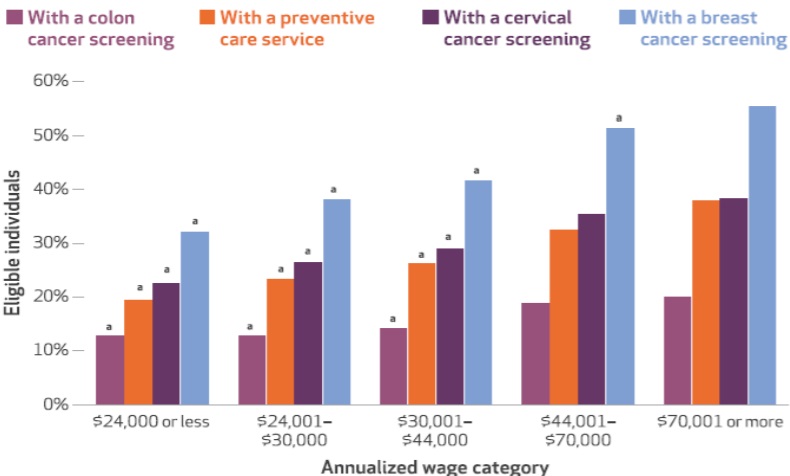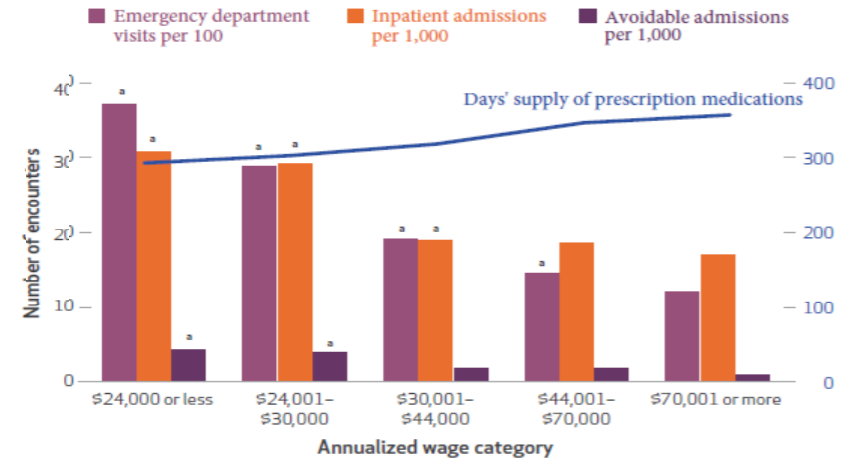
Middle-range earners had lower use, and less misuse, of health services
High-wage earners spend the most, per patient, on health care in the U.S., a new study finds. But the lowest-wage workers were the next biggest spenders on health care. In a Goldilocks scenario, those earning in the middle ranges were the least apt to misuse and overuse health care services.
The study report, Health Care Use and Spending Patterns Vary by Wage Level in Employer-Sponsored Plans, examined health care use and spending by wage level during 2014 among 42,936 employees of four self-insured employers enrolled in a private health insurance exchange. The researchers discovered that:
- Annual total health care spending was highest among those earning above $70,000, who on average spent $5,074 per patient per year.
- Those earning $24,000 or less weren’t far behind, spending on average $4,835 per patient per year.
- Middle-wage earners had, on average, less than $4,000 per patient per year in health care spending.
Study co-author Bruce W. Sherman, M.D., medical director for population health management at consultancy Conduent HR Services and an assistant clinical professor at Case Western Reserve University School of Medicine in Pittsburgh, discussed the results and their implications during a Feb. 7 forum in Washington, D.C. The findings were published in the February 2017 issue of the journal Health Affairs, which sponsored the event.
Preventive Care vs. ER Use
When demographics and other characteristics were controlled for, employees in the lowest-wage group had, relative to top-wage earners, half the usage of preventive care, nearly twice the hospital admission rate, more than four times the rate of avoidable admissions and more than three times the rate of emergency department visits.
Summarizing the key findings, Sherman noted that:
- Low-wage workers use health care in a more reactive and inefficient pattern, with associated comparatively higher expenditures.
- High-wage earners’ similarly high health care expenditures are perhaps due to a relative lack of barriers to care. Their costs are driven by outpatient service, and they spend the most on preventive care services, including cancer screenings.

But high-earners are also the most likely to use their coverage for expensive and often unnecessary tests and procedures, such as the use of CT scans for minor and temporary health issues.
Much of low-wage workers’ use of emergency rooms and inpatient services “is avoidable with proper use of the health care system,” Sherman said. But many of these workers won’t go for preventative care services, which the Affordable Care Act requires health plans to cover outside of deductibles, because “they worry if the doctor finds something, they won’t be able to afford treatment.”

He advised that policymakers apply these findings to employer benefit plan design strategies and research priorities “to encourage effective use of health care services.”
For employers, “thoughtful management of low-wage workers’ health may have a measurable impact on business performance,” Sherman said.
He also suggested that health benefit plan designs might “hold accountable [high-wage employees] for what could be deemed their overuse of services,” perhaps by increasing the level of cost-sharing based on individuals’ ability to pay.
Source: https://www.shrm.org/resourcesandtools/hr-topics/benefits/pages/healthcare-spending.aspx
